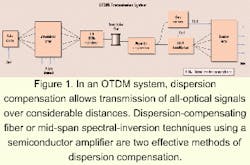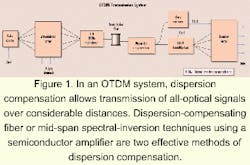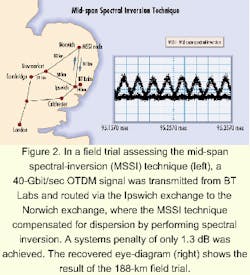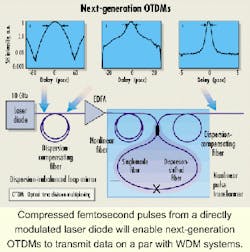Optical TDM makes faster networks possible
Richard Penty, University of Bristol
The demand for increased optical-communications capacity has fueled great interest and investment in wavelength-division multiplexing (WDM), which has become the technology of choice to meet this need. So where does that leave time-division multiplexing (TDM), the other main technique for multiplexing data using optical signals?
Traditionally TDM has been carried out using electronics, with 10-Gbit/sec speeds commercially available and 40-Gbit/sec products to be released over the next year or so by a variety of companies. To go to faster single-channel bit rates, however, it is necessary to further multiplex in the optical domain-optical time-division multiplexing (OTDM). Unlike WDM, where multiplexing is achieved by carrying many relatively low-bandwidth channels on separate wavelengths, OTDM multiplexes the channels in the time domain to result in a single wavelength carrying an extremely high data rate.Optical time-division multiplexing is typically achieved by a process called bit interleaving, in which a high-frequency pulse train, say at a repetition rate of 10 GHz, is split N ways. Each split pulse train is then modulated with data, after which it is delayed by a time equal to 1/N of the original pulse-train period relative to its neighbor. The N-modulated pulse trains are then recombined to form a return-to-zero (RZ) signal that has an aggregate data rate of Nx10 Gbit/sec. The coding of an RZ signal has a signal level that returns to a nominal zero level between bits, regardless of whether the next bit is 0 or 1; conversely, a non-return-to-zero (NRZ) signal does not return to a nominal zero but remains at one if two successive 1 bits are transmitted.
The main elements of an OTDM transmission system include a pulsed source, a method of transmitting the signals, and a demultiplexer at the receiver (see Figure 1). The transmission performance of OTDM signals is an important issue, with the achievable transmission distance of an optical signal over a given fiber inversely proportional to the square of its bandwidth.
To improve performance, the University of Bristol (Bristol, England) has been involved in the European collaborative ACTS (Advanced Communications, Tech nologies, and Services) project HIGHWAY (photonic technologies for ultra-high-speed information highways), which has recently concluded. In this project, 40-Gbit/sec OTDM signals were transmitted over standard singlemode fiber. Typical pulses were of 5-psec duration with an optical bandwidth of approximately 100 GHz, resulting in a maximum transmission over standard fiber (dispersion 17 psec/nm-km) of less than 5 km before complete loss of signal integrity.
To obtain acceptable transmission distances, dispersion compensation techniques must be applied. In the HIGHWAY project, improvement was achieved using dispersion-compensating fiber or by mid-span spectral inversion (MSSI) in a semiconductor optical amplifier (SOA). In standard fiber, the high-frequency (blue) components of an optical pulse travel faster than the low-frequency (red) components, and consequently the pulse spreads out.
The MSSI technique compensates for the pulse spreading by inverting the signal spectrum-usually with a process called four-wave mixing-at a point halfway along the transmission link. Thus the original blue components of the pulse become red and vice versa. As the pulse propagates down the second half of the link, it effectively experiences a negative dispersion and so shortens again until it is at its original duration at the fiber output (see Figure 2).At the end of the transmission link, the individual channels need to be demultiplexed from the OTDM bit stream. First, a clock must be extracted from the bit stream-a process that can be carried out electronically or, more promising for future ultra-high-speed systems, all-optically. Electronic methods often make use of phase-locked loops, whereas all-optical techniques include the frequency locking of modelocked or self-pulsating lasers. The extracted clock is then used to drive the demultiplexing element, which opens up a short switching window repeated at the clock rate to switch out the channel required. There are many different types of demultiplexers, including electronically driven electroabsorption modulators or all-optical nonlinear devices such as terahertz optical asymmetric demultiplexers (TOADS).
One interesting variant needed for OTDM networks is the add-drop multiplexing node where a channel is extracted (dropped) from the OTDM bit stream and a local channel interleaved (added) into the empty time slot. An experimental implementation of this was carried out in a collaboration between the Technical University of Denmark (TUD; Lyngby, Denmark) and ETH-Zurich (Zurich, Switzerland) within the HIGHWAY project. In the demonstration, two SOAs were placed in the arms of a Mach-Zehnder interferometer and a phase change in each arm induced with picosecond control pulses. Differential injection of short control pulses into each arm resulted in ultrashort switching windows.Appropriate timing of the switching window Dt can result in demultiplexing (dropping) of one channel from the OTDM bit stream to one output, leaving the remaining channels to be routed to the second output for distribution to the network. A further channel can be added simultaneously by injecting into the second Mach-Zehnder input. The Technical University of Denmark and ETH-Zurich have demonstrated the device functionality by add-drop multiplexing 10-Gbit/s RZ channels from a 40-Gbit/sec OTDM data stream (see Figure 3).
The TUD work shows one major advantage of OTDM systems over WDM. As data services begin to supersede voice on optical systems, networks are likely to evolve away from circuit-switched approaches to packet switching. Optical packet-switched networks, however, need a set of complex all-optical functions such as buffering, header reading, erasing and rewriting, and packet routing.
Although all-optical packet routing of WDM channels is possible, the conventional NRZ signal format used by WDM does not lend itself to all-optical signal processing at the bit level, so header manipulation and processing must be carried out electro-optically. Important work at BT Labs (Ipswich, England) has shown that the RZ format used within OTDM systems readily allows all-optical bit-level processing, thus making possible header manipulation function at ultra-high speeds.
Despite some advantages, OTDM has been left standing by WDM in the commercial world, and there are no OTDM systems commercially available. In the laboratory, though, many organizations are carrying out OTDM systems experiments. Lucent Technologies (Holmdel, NJ), for example, has transmitted an 8x20-Gbit/sec OTDM signal over 300 km of nonzero-dispersion-shifted fiber,1 while NTT (Tokyo) has transmitted a 640-Gbit/sec OTDM signal over 60 km of fiber.2 So what are the limits? Will OTDM systems be able to match the few terabits per second that WDM has already achieved in the laboratory?
To answer these questions it is necessary to look at the likely future performance of perhaps the most critical OTDM subsystem-the pulse source, which has to generate extremely high-repetition-rate, ultrashort, transform-limited pulses with extremely low pulse pedestals. The University of Bristol has produced 300-fs pulses with less than -45-dB pedestals using nonlinear pulse compression, suitable for 1-Tbit/sec OTDM. The Femto second Technology Research Association (Tsukuba, Japan) has produced 20-fsec pulses (an amazing four optical cycles long) using a multistage nonlinear fiber compressor. While this source needs work to improve the pedestal suppression, the pulsewidth is suitable for 10 Tbit/sec OTDM.
It appears, therefore, that OTDM systems may be capable of achieving data rates similar to those of WDM-so the question arises as to which will be the best solution for multiterabit all-optical networks. The answer may well be a hybrid WDM/OTDM solution, in which high-capacity OTDM channels are multiplexed onto different wavelengths.
This development would allow optical signal processing with two levels of granularity. The WDM channels could be switched with coarse granularity using passive components such as array waveguides or Bragg gratings, while fine switching-perhaps of optical packets-of the OTDM channels could be achieved with the more-flexible bit-level optical processing available to RZ signals.
Richard Penty is a reader in the electrical and electronic engineering department at the University of Bristol (United Kingdom). He can be reached at email: [email protected].
The author would like to thank Derek Nesset of BT Labs and Henrik Poulsen of TUD for permission to use some of the figures in this article.
- B. Mikkelsen et al., Postdeadline paper PD2-3, ECOC '99, Nice, France (1999).
- M. Nakazawa et al., Electron. Lett. 34(9), 907 (1998).
This article appeared in the January 2000 issue of Laser Focus World, Lightwave's sister publication.
Data transmission in future optical time-division multiplexing (OTDM) systems will require high-quality femtosecond pulse sources.
Recently, at the University of Bristol, we demonstrated a new, simple technique enabling high-quality femtosecond pulse generation from a directly modulated laser diode by means of pulse compression and transformation in a compact nonlinear pulse transformer.
The technique is based on a fiber pulse compressor followed by a dispersion-imbalanced loop mirror (DILM). This source allows the generation of extremely high-quality femtosecond pulses on demand with strong suppression of pulse pedestals to overcome the problem of coherent noise that can occur during OTDM bit interleaving.A gain-switched multiple-quantum-well distributed-feedback laser driven at 10 GHz produces pulses of 20-psec duration. The resulting pulses are linearly chirped so that they can be readily compressed in a length of dispersion-compensating fiber to a duration of 6 psec. These pulses are amplified and compressed in a nonlinear fiber to a length of approximately 1 psec (see Figure).
The pulses are then launched into a DILM, which incorporates 100 m of singlemode fiber and the same length of dispersion-shifted fiber. The short-pulse component of the signal experiences a nonlinear phase difference between clockwise and counterclockwise waves because of the asymmetric dispersion of the loop and thus is transmitted through the loop while the CW and long-pulse components are reflected back.
As a result of the nonlinear propagation through the DILM, the output pulses are of ~10-psec duration and possess considerable phase modulation. The pulses are compressed in an additional length of dispersion-compensating fiber to a duration of 300 fsec. The compressed pulses are of very good quality, with residual picosecond pedestal approximately 45 dB below the peak power. The 300-fsec pulsewidth is short enough that 100x10-Gbit/sec OTDM should be possible.
- I. Y. Khrushchev et al., Electron Lett. 35(14), 1183 (1999).




